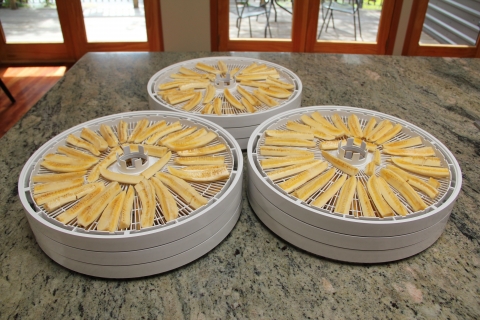
How much food dehydrator capacity do you need?
One of the more confusing aspects of food dehydrators is their capacity. In this article, we’ll review how dehydrator capacity is measured, and take a look at the capacity of a couple popular food dehydrators. We’ll also look a specific example how much capacity we needed to dry four bunches of bananas.
Food dehydrators all use trays, so capacity is determined by calculating the area of each tray and then multiplying that number by the total number of trays. To help illustrate, let's look at two popular dehydrators, the Excalibur 3900 and the NESCO 1018P Gardenmaster.
Capacity of the Excalibur 3900
The Excalibur 3900 comes with 9 trays that measure 15” x 15”, and each tray has a calculated area of 15” x 15” = 225 square inches = 1.7 sq. ft. When we multiply 1.7 sq. ft. by 9 trays, we get a total drying area of 15 sq. ft.
Capacity of the NESCO 1018P Gardenmaster
The NESCO 1018P is a classic stacking dehydrator with round trays. Each tray is 15.5” in diameter and provides 1 square foot of drying area. The 1018P ships with 8 trays, so has 8 square feet of base drying area. The Gardenmaster 1018P can handle up to 30 trays, so it has a maximum drying capacity of 30 square feet.
Capacity comparison chart
Four bunches of bananas
So, how much capacity will you need? We recently dried 4 bunches of bananas (about 28 bananas total) using the NESCO Gardenmaster 1018P.
The bananas were cut into strips then arranged on trays. We needed 9 trays total to handle all of the bananas.
Without peels, the bananas weighed about 8.2 pounds before drying. Since each NESCO tray provides 1 square food of drying area, we used a little less than 1 square foot per pound of bananas. Also note that because the bananas were quartered, they used up less space than a similar amount of food sliced more thinly.
Finally, here's our final dried banana strips. At just over two pounds, they now fit in a medium-size bowl.
See our recipe for banana strips here.







Add new comment